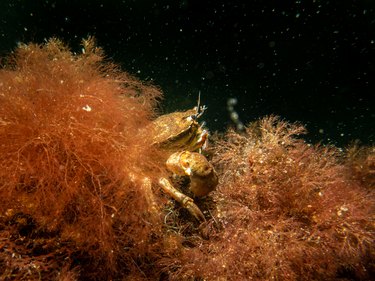Whether in the wild or in captivity, crabs are omnivores that eat a combination of plant and animal food sources. The omnivorous diet for crabs in the wild still differs greatly from what you might feed your pet hermit, red claw, and fiddler crabs. Hermit crabs are the most common pet crabs and are omnivores that can eat frozen brine shrimp and fruit-based reptile food from the pet store.

Video of the Day
The are approximately 100 different fiddler crab species. Specifically, fiddler crabs are detritivores, meaning they sift through substrate looking for dead matter to eat. In the wild, fiddler crabs don't wander far from their burrow to eat. So feeding them shrimp pellets that fall to the bottom of the tank is a good idea.
Video of the Day
Crabs are omnivores
Many animals, including humans, are characterized as omnivores. Unlike herbivores who eat only plant life and carnivores who eat only meat, omnivores regularly consume both types of food giving them a more diverse diet. Types of fish, birds, reptiles, and mammals all fall under this category along with crabs. There aren't any carnivorous crabs.
Wild crab diet
In the wild, crabs eat a variety of plants and animals. For example, the blue crab is native to the Atlantic Ocean along the East Coast and eats live plants, snails, fish, crustaceans, and other blue crabs. The Alaskan king crab makes its home in the waters around Alaska and Russia where they eat bryozoans and other colony plant life when they are young.
As Alaskan king crabs grow they begin eating clams, sea urchins, sand dollars, barnacles, mussels, fish, and algae. Both the snow crab in Alaska and the Dungeness crab from the Pacific Northwest eat any life forms they can find at the bottom of the sea or ocean, respectively. As these examples illustrate, a variety of crabs in different native environments thrive on diverse diets including both plant and animal life.
Pet crab diet
Like wild crabs, most pet crabs also require a diverse diet. Hermit crabs, for example, live on fruit, plants, grasses, decayed wood, and any animal protein that happens to come ashore when they are in the wild. Pet hermit crabs need similar diversity. In fact, hermit crabs prefer different foods at each feeding. Pet hermit crabs can be given a wide variety of foods, including the following:
- Coconuts
- Nuts
- Nonstarchy vegetables
- Raisins
- Peanut butter
- Cooked eggs
- Fresh fish
- Cereal
- Crackers
- Tree bark
- Popcorn
- Fresh shellfis
- Cooked meat
- Honey
- Mangoes
- Papayas
Hermit crabs also enjoy snacks of frozen plankton, dried seaweed, fruit-based reptile food, and drained brine shrimp. Hermit crabs are sensitive to metal so only serve their food in ceramic or plastic dishes. They also eat very slowly and take small bites, usually eating at night. Other pet crabs such as the red claw, fiddler, and Thai devil crabs also need omnivorous diets in captivity.
Care of pet crabs
Care instructions for all of these pet crab species specifically recommend they be fed a variety of foods so they receive all of the nutrients they need. In fact, owners who rely primarily on sinking food pellets for their crabs should alternative between those based on algae and those based on protein to ensure the crabs stay healthy. Fiddler crab species, in particular, can eat dried plankton, brine shrimp flakes, as well as pieces of fruit and vegetables.